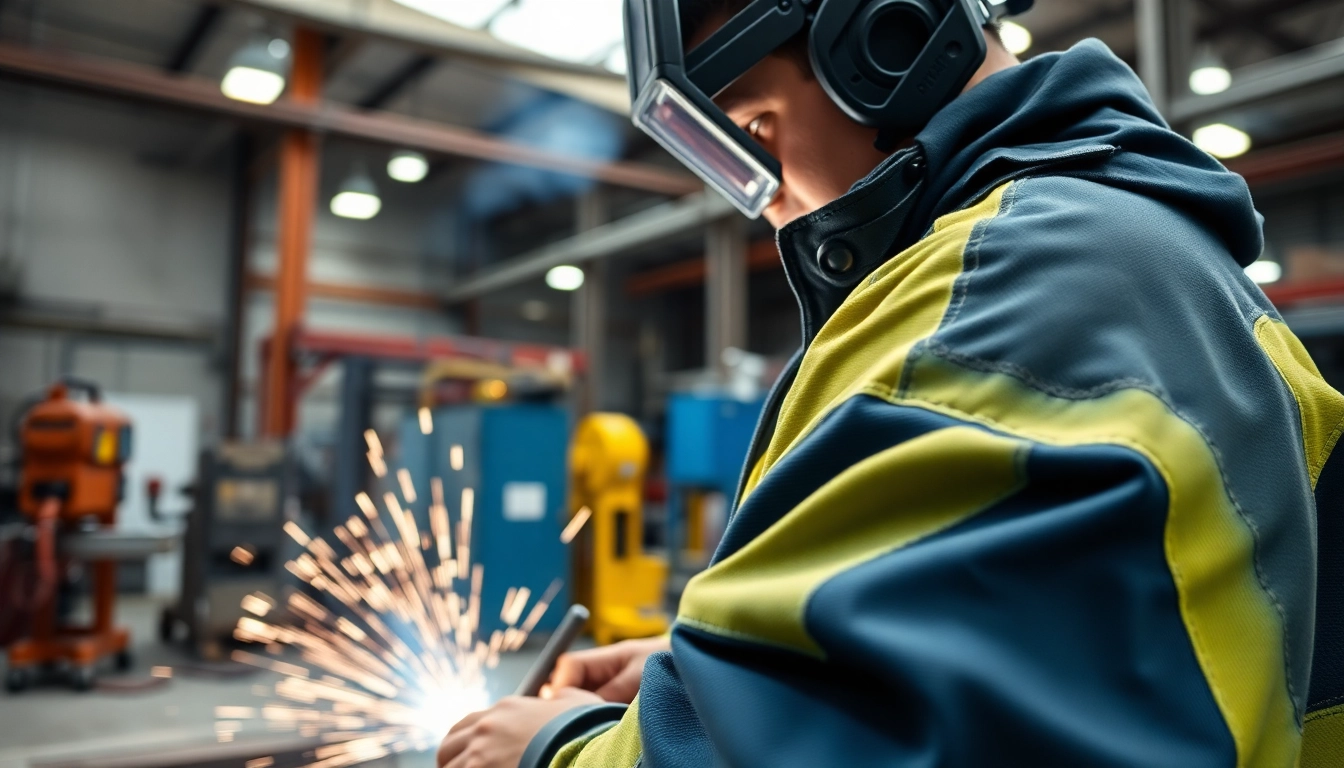Understanding Welding Jackets
What is a Welding Jacket?
A welding jacket is an essential piece of protective clothing designed for welders and metal workers. Unlike regular jackets, welding jackets are specifically engineered to protect the wearer from the intense heat, sparks, and potential fire hazards associated with various welding processes. Made from materials that are flame-resistant, they provide both comfort and security during welding tasks. A good welding jacket not only protects the wearer from burns and injuries but also enhances their overall work efficiency by offering ease of movement and breathability.
Key Features of Welding Jackets
When selecting a welding jacket, understanding its key features is crucial for ensuring safety and comfort:
- Flame Resistance: Welding jackets are typically made from materials such as flame-resistant cotton and leather, which can withstand high temperatures and prevent ignition.
- Durability: The construction of these jackets involves reinforced seams and high-quality fabrics to ensure they last through the wear and tear of welding tasks.
- Comfort and Fit: A well-fitted jacket offers mobility while working. Many jackets feature adjustable cuffs and waistbands to accommodate different body sizes and types.
- Additional Protection: Many welding jackets come with features like high collars, extended lengths, and sleeves that provide extra coverage against sparks and spatter.
- Pockets: Storage is also a consideration. Many jackets include pockets for tools, personal items, or welding accessories.
Types of Welding Jackets
Welding jackets come in various styles and materials, each catering to different needs and preferences:
- Cotton Jackets: Lightweight and breathable, cotton jackets are a popular choice among welders for light-duty applications. They often come pre-treated for flame resistance.
- Leather Jackets: Offering excellent protection and durability, leather jackets are ideal for heavy-duty welding jobs. They provide superior coverage against extreme heat and spatter.
- Hybrid Jackets: Combining the best features of both cotton and leather, hybrid jackets typically include leather sleeves with a cotton body, offering flexibility and protection.
- Hi-Visibility Jackets: These are designed with bright colors or reflective elements to enhance visibility in low-light conditions, making them suitable for outdoor or industrial work.
The Importance of Safety in Welding
Hazards of Welding
Welding is an inherently dangerous activity due to the various hazards present. Understanding these risks is essential for maintaining a safe working environment:
- Burns: The intense heat produced during welding can lead to severe burns if proper protective clothing is not worn.
- Fumes and Gases: The process generates harmful fumes and gases, which can lead to respiratory problems if inhaled over time without proper ventilation.
- Arc Radiation: The electric arc created during welding generates ultraviolet (UV) and infrared (IR) radiation, which can cause serious eye damage (arc eye) and skin burns.
- Electrical Hazards: Welding equipment carries electrical risks, which increase if proper safety protocols are not followed.
Benefits of Using a Welding Jacket
Donning a welding jacket is essential for every welder for several reasons:
- Protection Against Burns: Jackets shield the skin from sparks, spatter, and heat, considerably reducing the risk of burns.
- Comfort: Modern welding jackets are designed with comfort in mind, allowing for ease of movement without compromising safety.
- Professional Appearance: Wearing the appropriate safety gear reflects professionalism and adherence to safety standards.
Regulatory Standards and Compliance
The welding industry is subject to strict safety regulations to protect workers. Understanding the regulatory standards relevant to welding jackets is crucial:
- OSHA Regulations: The Occupational Safety and Health Administration (OSHA) mandates specific requirements for personal protective equipment (PPE) to ensure worker safety.
- ANSI Standards: Welding jackets should comply with American National Standards Institute (ANSI) standards related to flame-resistant garments.
- Industry Certifications: Look for jackets certified by reputable organizations that verify their flame resistance and overall safety.
Choosing the Best Welding Jacket for Your Needs
Factors to Consider
Choosing the right welding jacket involves evaluating several key factors:
- Type of Welding: The welding type (MIG, TIG, Stick) can influence the choice of jacket based on the exposure to sparks and heat.
- Environment: Consider factors like outdoor vs. indoor work, cold weather conditions, and requirements for high visibility.
- Comfort and Fit: Choose a jacket that allows freedom of movement and fits snugly without being restrictive.
- Material: Select between cotton, leather, or hybrid materials based on your professional needs and preferences.
Material Comparison: Leather vs. Cotton vs. Synthetic
Understanding the properties of different materials is essential for making an informed decision:
- Leather: Tough and durable, leather jackets offer superior protection against high heat but can be heavy and less breathable.
- Cotton: More breathable and lightweight, cotton jackets provide comfort but may not offer the same level of protection as leather.
- Synthetic Fabrics: Some jackets use blends of materials designed for increased flexibility and comfort, though they may not always meet flame-resistance standards.
Size and Fit for Optimal Comfort
Achieving the right size and fit is crucial for optimal performance:
- Measurement: Take accurate body measurements and refer to the manufacturer’s sizing chart to ensure a proper fit.
- Layering: Ensure your welding jacket allows for additional clothing layers underneath without compromising mobility.
- Movement: Test the range of motion by raising your arms and bending at the waist, ensuring the jacket moves with you rather than restricting movement.
Top Brands of Welding Jackets
Leading Manufacturers in the Industry
Several brands are recognized for producing high-quality welding jackets:
- Miller Electric: Known for durable and innovative welding gear, Miller offers jackets suitable for various welding styles.
- Lincoln Electric: A respected name in welding, Lincoln produces flame-resistant jackets popular among professionals.
- Tillman: Specializing in affordable yet quality gear, Tillman showcases a broad range of welding jackets with excellent protection.
Budget-Friendly Options
For those on a budget, numerous affordable welding jackets are available without compromising safety:
- Revco Black Stallion: Offers a selection of economical jackets suitable for both hobbyists and professionals.
- Harrison’s Welding Supply: Provides a variety of jackets at competitive prices that meet industry safety standards.
- Amazon Basics: Budget-friendly welding jackets that come with essential protective features.
High-End Choices for Professionals
For industrial use or high-end applications, several premium brands set the benchmark for quality:
- Carhartt: Offering rugged work gear, Carhartt’s welding jackets boast durability and style with enhanced protection.
- FR Gear: Specializes in flame-resistant clothing, producing jackets specifically engineered for high-end industrial applications.
- Up In Smoke: Provides stylish yet functional welding jackets, with options available in unique designs and cuts.
Maintenance and Care for Your Welding Jacket
Cleaning Tips for Different Materials
Proper care of your welding jacket is vital for extending its lifespan:
- Cotton: Wash in cold water using mild detergent. Avoid fabric softeners and tumble drying, which can compromise flame-resistance.
- Leather: Wipe with a damp cloth and use a specialized leather cleaner to maintain suppleness. Avoid soaking the leather.
- Synthetic: Check the manufacturer’s instructions for specific wash settings. Generally, they can be machine-washed on a gentle cycle.
Inspecting and Repairing Wear and Tear
Regular inspection for wear and tear can prevent accidents:
- Check Seams: Inspect stitched seams for fraying or damage, which can lead to garment failure.
- Patching: Small tears can often be patched with flame-resistant fabric; consult a professional for larger repairs or if the jacket is heavily damaged.
- Replacing Fasteners: Ensure buttons, zippers, and snaps are functional; replace any that are worn or broken.
When to Replace Your Welding Jacket
Recognizing when it’s time to retire your welding jacket can save you from potential hazards:
- Visible Damage: If you notice significant burns, holes, or extensive wear, consider replacing the jacket immediately.
- Loss of Flame Resistance: If the jacket has been exposed to harsh conditions repeatedly, it may lose its protective properties.
- Fit Issues: A jacket that no longer fits properly can hinder movement and protection; it may be time for a new jacket.


